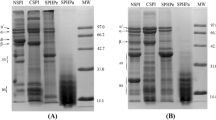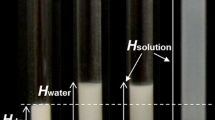Abstract
There is a growing market for formulating proteins into a wide variety of products including laundry detergents, bath products, shampoos, and skin cleansers. Soy protein isolate (SPI), soy protein hydrolysate A (SPHA) from papainmodified SPI, and hydrolysate B from papain- and proteasemodified SPI were used in blends with three major detergents, sodium dodecyl sulfate (SDS), sodium laureth sulfate (SLS), and disodium lauryl sulfosuccinate (DSLSS). SPHA was used to partially replace these detergents in bath soap, conditioning shampoo, and cream hand cleanser. The effectiveness of SPI, SPHA, or SPHB blends with the three detergents and their influence in prototype products on foaming and emulsifying properties were investigated.
At a blending ratio of 75% detergents and 25% proteins (75∶25), the foaming capacities (FC) were the same as detergents alone without adding proteins (100∶0); at 50∶50 blending ratio, FC values were not significantly reduced for blends with SDS and SLS; and at 25∶75 ratio the FC values were significantly lower, especially for blends with DSLSS. When replacing up to 100% of the major detergents in the skin and hair care products with SPHA, FC values remained almost unchanged except for hand cleanser FC values, which were lower at higher protein content (75 and 100%). In contrast with FC performance, emulsion stability (ES) values for all products increased with increasing soy protein content. Furthermore, FC and ES values for detergents blended with SPHA or SPHB were not significantly different from each other, but these values were always higher than those for detergents blended with SPI. Products in which soy protein or soy protein hydrolysates were used to partially replace detergents not only retained excellent foaming properties but also exhibited enhanced emulsifying properties. These results indicate that modified soy proteins may be used in laundry and cosmetic products to fulfill market demand.
Similar content being viewed by others
References
Gallagher, K.F., Hydrolyzed Vegetable Protein: A Formulators' Guide, Part I, Drug Cosmet. Ind. 148 (August):34–38 (1991).
Taglia, A., and G. Secchi, New Protein Ingredients for Skin Detergency: Native Wheat Protein-Surfactant Complexes, Int. J. Cosmet. Sci. 16:235–246 (1994).
Wurdinger, V., hair Care Additives: From the Rainforest to the Test Tube, the Focus Is on Efficacy, Drug Cosmet. Ind. 157:221–228 (1995).
Taglia, A., G. Mazzola, and G. Secchi, Relationships Between Chemical Characteristics and Cosmetic Properties of Protein Hydrolysates, Cosmet. Toiletries 108:56–65 (1993).
Tomita, M., Y. Fukuwatari, T. Kitazawa, M. Nojiri, and S. Kawaura, Milk Protein Hydrolysates and Compositions for Use as Hair and Skin Treating Agent, European Patent Application, 91304353.5 (1991).
McIntyre Group Ltd., A Guide to Formulating Mild Sulfosuccinate Products, McIntyre Group Ltd., University Park, IL, 1995, 15 pp.
ASTM, Standard Test Method of Foaming Properties of Surface-Active Agents, in Annual Book of ASTM Standards 15.04: 108–109, D 3707-89 (1992).
ASTM, Standard Test Method for Stability of Water-in-Oil Emulsions by the Oven Test Method, in Annual Book of ASTM Standards 14.02:530–532, D 3707-89 (1994).
SAS, A SAS User's Guide: Statistics, Version 5 edn., SAS Institute Inc., Cary (1990).
Wingrave, J.A., and T.P. Matson, Are Theoretical Surface Chemistry Measurements Really Practical? J. Am. Oil Chem. Soc. 58:347A-355A (1981).
Galante D.C., and K.W. Dillan, Heavy-Duty Laundry Detergents, —Ibid. 58:356A-362A (1981).
Maase, F.W.F.L., and R. Van Tilburg, The Benefit of Detergent Enzymes Under Changing Washing Conditions-—Ibid. 60: 1672–1675 (1983).
Starace, C.A., Detergent Enzymes—Past, Present and Future, —Ibid. 60:1025–1027 (1983).
Brooks, G.J., Pseudocollagenous Proteins from Yeast, Drug Cosmet. Ind. 150:42–43 (1992).
Author information
Authors and Affiliations
Corresponding author
About this article
Cite this article
Wu, W., Hettiarachchy, N.S. Foaming and emulsifying properties of soy protein isolate and hydrolysates in skin and hair care products. J Surfact Deterg 1, 241–246 (1998). https://doi.org/10.1007/s11743-998-0026-2
Received:
Accepted:
Issue Date:
DOI: https://doi.org/10.1007/s11743-998-0026-2




